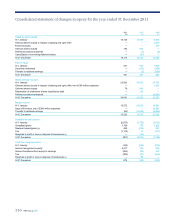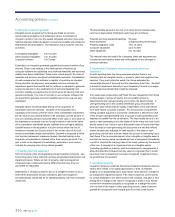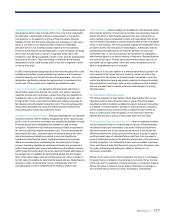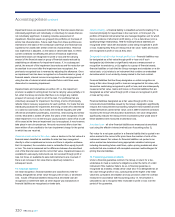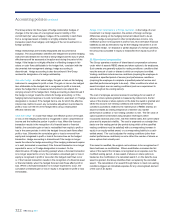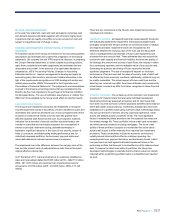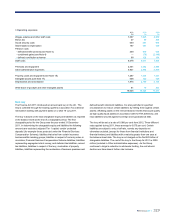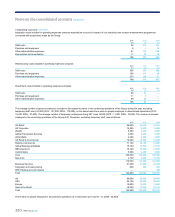RBS 2011 Annual Report Download - page 322
Download and view the complete annual report
Please find page 322 of the 2011 RBS annual report below. You can navigate through the pages in the report by either clicking on the pages listed below, or by using the keyword search tool below to find specific information within the annual report.
320 RBS Group 2011
Impairment losses are assessed individually for financial assets that are
individually significant and individually or collectively for assets that are
not individually significant. In making collective assessment of
impairment, financial assets are grouped into portfolios on the basis of
similar risk characteristics. Future cash flows from these portfolios are
estimated on the basis of the contractual cash flows and historical loss
experience for assets with similar credit risk characteristics. Historical
loss experience is adjusted, on the basis of observable data, to reflect
current conditions not affecting the period of historical experience.
Impairment losses are recognised in profit or loss and the carrying
amount of the financial asset or group of financial assets reduced by
establishing an allowance for impairment losses. If, in a subsequent
period, the amount of the impairment loss reduces and the reduction can
be ascribed to an event after the impairment was recognised, the
previously recognised loss is reversed by adjusting the allowance. Once
an impairment loss has been recognised on a financial asset or group of
financial assets, interest income is recognised on the carrying amount
using the rate of interest at which estimated future cash flows were
discounted in measuring impairment.
Impaired loans and receivables are written off, i.e. the impairment
provision is applied in writing down the loan's carrying value partially or in
full, when the Group concludes that there is no longer any realistic
prospect of recovery of part or all of the loan. For portfolios that are
collectively assessed for impairment, the timing of write off principally
reflects historic recovery experience for each portfolio. For loans that are
individually assessed for impairment, the timing of write off is determined
on a case-by-case basis. Such loans are reviewed regularly and write
offs will be prompted by bankruptcy, insolvency, restructuring and similar
events. Most debt is written off within five years of the recognition of the
initial impairment. It is not the Group’s usual practice to write-off all or part
of the asset at the time an impairment loss is recognised; it may however,
take place in rare circumstances. Amounts recovered after a loan has
been written off are credited to the loan impairment charge for the period
in which they are received.
Financial assets carried at fair value - when a decline in the fair value of a
financial asset classified as available-for-sale has been recognised
directly in other comprehensive income and there is objective evidence
that it is impaired, the cumulative loss is reclassified from equity to profit
or loss. The loss is measured as the difference between the amortised
cost of the financial asset and its current fair value. Impairment losses on
available-for-sale equity instruments are not reversed through profit or
loss, but those on available-for-sale debt instruments are reversed, if
there is an increase in fair value that is objectively related to a
subsequent event.
17. Financial liabilities
On initial recognition, financial liabilities are classified into held-for-
trading; designated as at fair value through profit or loss; or amortised
cost. Issues of financial liabilities measured at amortised cost are
recognised on settlement date; all other regular way transactions in
financial liabilities are recognised on trade date.
Held-for-trading - a financial liability is classified as held-for-trading if it is
incurred principally for repurchase in the near term, or forms part of a
portfolio of financial instruments that are managed together and for which
there is evidence of short-term profit taking, or it is a derivative (not in a
qualifying hedge relationship). Held-for-trading financial liabilities are
recognised at fair value with transaction costs being recognised in profit
or loss. Subsequently they are measured at fair value. Gains and losses
are recognised in profit or loss as they arise.
Designated as at fair value through profit or loss - financial liabilities may
be designated as at fair value through profit or loss only if such
designation (a) eliminates or significantly reduces a measurement or
recognition inconsistency; or (b) applies to a group of financial assets,
financial liabilities or both that the Group manages and evaluates on a fair
value basis; or (c) relates to an instrument that contains an embedded
derivative which is not evidently closely related to the host contract.
Financial liabilities that the Group designates on initial recognition as
being at fair value through profit or loss are recognised at fair value, with
transaction costs being recognised in profit or loss, and are subsequently
measured at fair value. Gains and losses on financial liabilities that are
designated as at fair value through profit or loss are recognised in profit
or loss as they arise.
Financial liabilities designated as at fair value through profit or loss
include structured liabilities issued by the Group: designation significantly
reduces the measurement inconsistency between these liabilities and the
related derivatives carried at fair value; and in 2009 investment contracts
issued by the Group's life assurance businesses: fair value designation
significantly reduces the measurement inconsistency that would arise if
these liabilities were measured at amortised cost.
Amortised cost - all other financial liabilities are measured at amortised
cost using the effective interest method (see Accounting policy 3).
Fair value for a net open position in a financial liability that is quoted in an
active market is the current offer price times the number of units of the
instrument issued. Fair values for financial liabilities not quoted in an
active market are determined using appropriate valuation techniques
including discounting future cash flows, option pricing models and other
methods that are consistent with accepted economic methodologies for
pricing financial liabilities.
18. Financial guarantee contracts
Under a financial guarantee contract, the Group, in return for a fee,
undertakes to meet a customer’s obligations under the terms of a debt
instrument if the customer fails to do so. A financial guarantee is
recognised as a liability; initially at fair value and, if not designated as at
fair value through profit or loss, subsequently at the higher of its initial
value less cumulative amortisation and any provision under the contract
measured in accordance with Accounting policy 13. Amortisation is
calculated so as to recognise fees receivable in profit or loss over the
period of the guarantee.
Accounting policies continued


